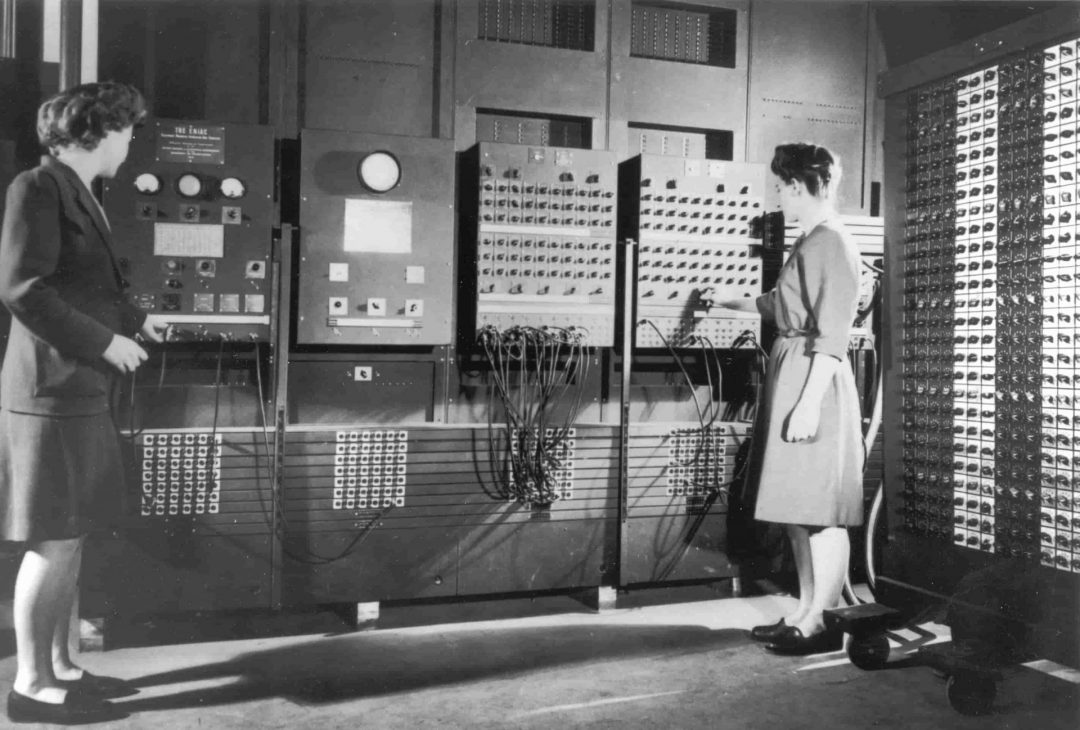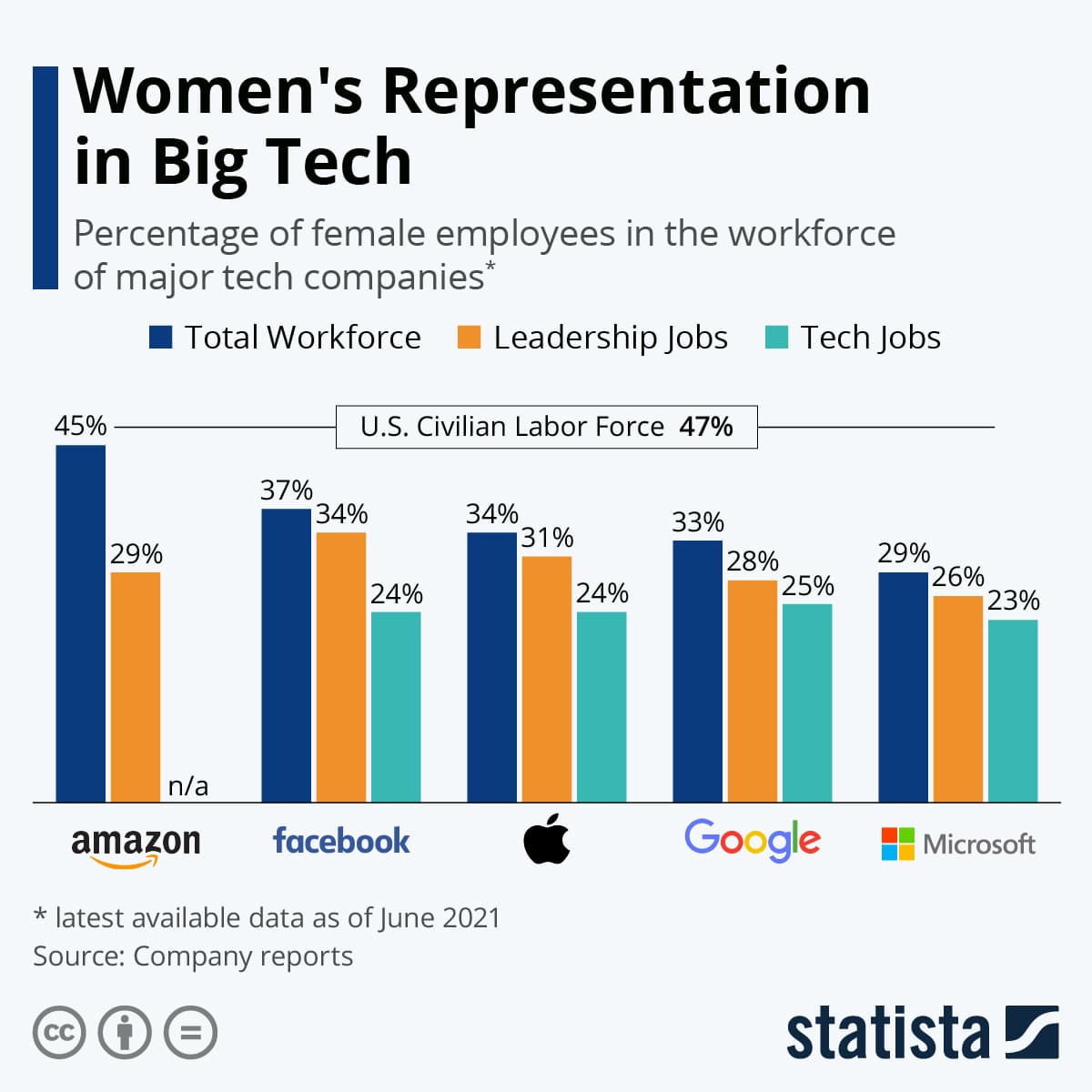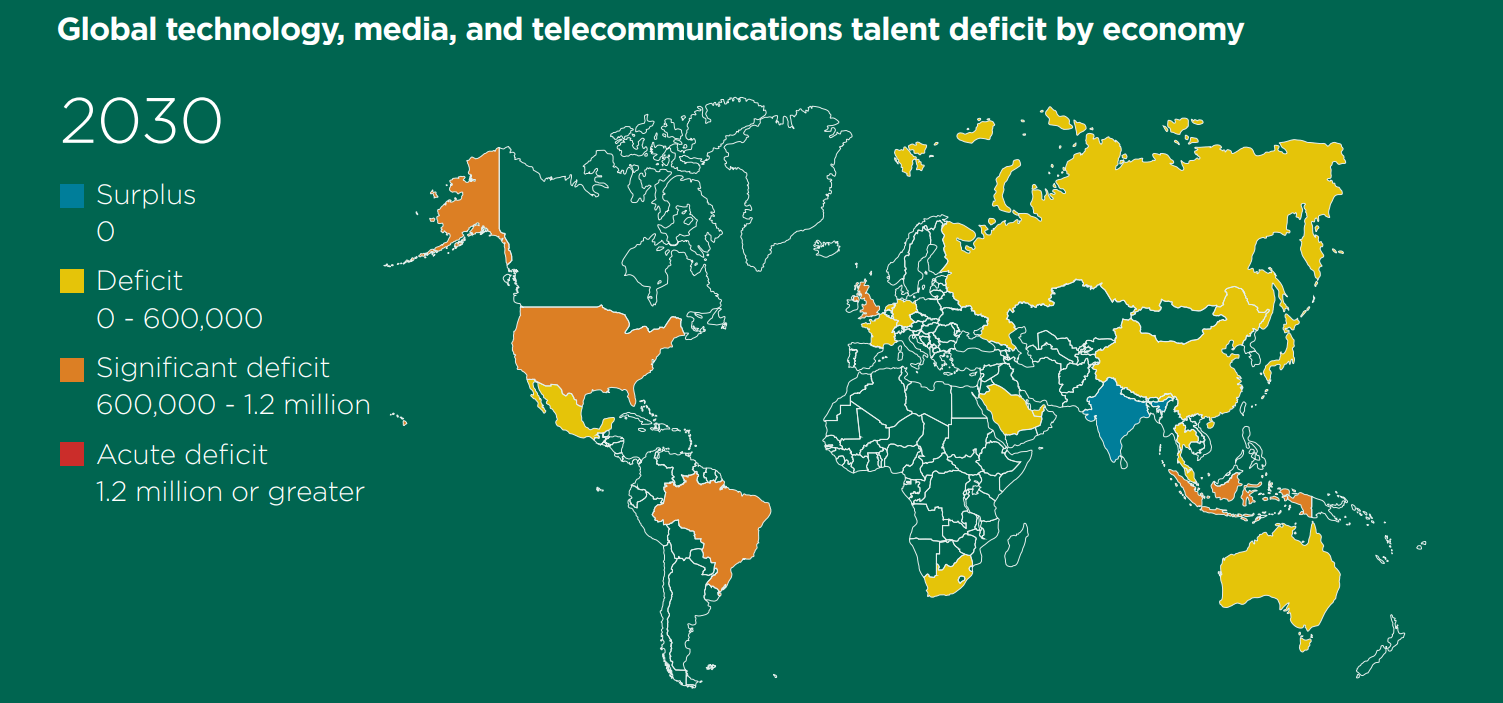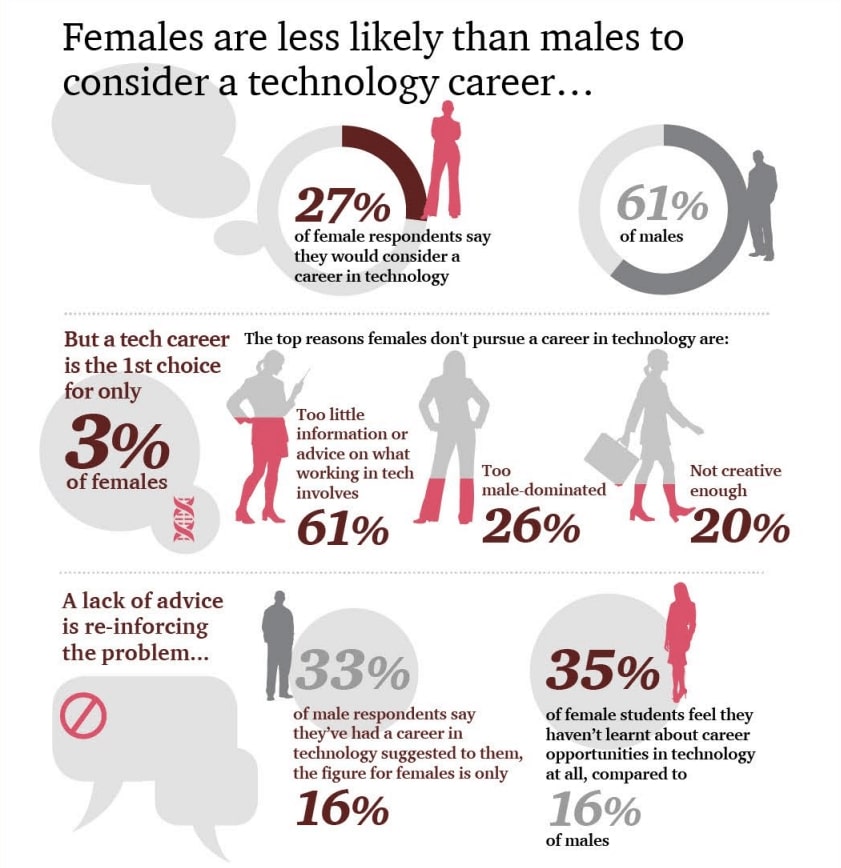Did you know that the first person ever to write a computer program was female? Ada Lovelace was a mathematician later considered to be the world’s first programmer. She wrote an algorithm for Charles Babbidge’s Analytical Engine to calculate the Bernoulli sequence of numbers.
Over a century later, we can’t say that men and women in tech are represented in equal numbers. But what are the reasons for the underrepresentation of women in technology? And why is gender diversity important for tech companies? In this article, we’ll answer those questions and look at the situation from different angles.
Why are there so few women in IT?
No one would argue that in today’s society, men and women differ in their interests. Without a doubt, these differences have a huge impact on the occupational gender gap.
But what is the reason for such a clear division of jobs into traditional female and male ones? Let’s consider the causes of the low percentage of women in IT in greater detail.
Gender stereotypes and expectations
In 1946, 6 women programmed ENIAC, the first electronic computer. The names of these brilliant female engineers were revealed to the public only in the 1980s. They are Frances Holberton, Jean Jennings, Ruth Lichterman, Kathleen McNulty, Frances Spence, and Marlyn Wescoff. Below, you can see the photo of ENIAC and part of its computing team that stands as a huge milestone for the history of women in tech.

Until the 1980s, even historians of computing thought that women in the pictures of ENIAC were only refrigerator ladies. It means that they were just posing around the machine to make it look more attractive.
The truth is that these ladies reduced the operation of ballistic calculations from 30 hours to mere seconds. They used only logical diagrams in times when there were no programming languages or compilers we have nowadays.
But why did even specialists never question the fact that there were no women in tech until the 1980s? There’s a common belief that women have an innate ability to learn human science, not STEM (science, technology, engineering, and maths). That’s why we’re more likely to portray a typical engineer as a male.
So, instead of opening the doors for more talented engineers, gender stereotypes merely closed them for females. They also spawned many biases and misconceptions about jobs for women in tech. And nowadays, we see that only 20% of engineers at Google are female. The women in IT stats below show a quite similar number across other big tech companies.

Also, the Athena Factor 2.0 survey states that 32% of women in US tech are likely to quit their jobs in the industry within a year. But why do gender stereotypes are so important that they stop women from daring and creating a women-inclusive world?
Stereotypes may have a strong psychological impact on individuals and create a ‘stereotype threat’. This term describes the fear of confirming negative stereotypes about the social group that the person belongs to.
Girls tend to have a more negative attitude towards mathematics than boys. Gender studies show that parents and teachers often have gender expectancies for children’s math skills. This, in turn, influences children’s maths attitudes and performance, leading to low female representation in tech.
Stereotype thinking is a brain’s mechanism meant to simplify information handling by linking it to familiar concepts. It’s important to note that stereotypes aren’t necessarily used on purpose. In fact, women often express traditional gender stereotypes along with men.
Why do we need more women in IT?
In XXI century society, concepts of equality, fairness, and social justice are generally welcomed. However, encouraging more women to choose a tech career isn’t just about ethics. There’s a rational and economic interest in creating more jobs for women in tech as one of the most innovative and rapidly growing domains.
Let’s dig into the positive outcomes of increasing the representation of women in technologies.
-
More effective problem-solving
What’s effective problem-solving actually? It’s all about defining the problem, coming up with alternatives, evaluating them, and applying end solutions. That’s where the diversity of thoughts can be of great help.
Let’s go into detail about why gender diversity is so important for businesses. The reason is that men and women have different perspectives and thus together can generate more unique and valuable ideas. Also, the team’s diversity helps to widen the client base by better attuning to its needs.
According to Harvard Business Review, companies that adhere to diversity outperform other companies. Diverse companies are 45% more likely to experience market share growth and 70% more likely to capture a new market.
That’s why increasing the percentage of women in IT will help businesses to understand the unmet needs of their users and boost performance.
-
Increased revenue
The McKinsey research states that companies with high diversity in executive teams are 21% more likely to have more return value. Moreover, HBR research states that the presence of female executives reduces the negative impact of the crisis. Also, the data show that the presence of at least one female director on the board correlates with better acquisition decisions.
-
Wide pool of talent for IT
Diversity policy helps increase the percentage of women in IT. Software engineering remains to be a field highly concerned by the shortage of certified specialists. Korn Ferry study states that by 2030, high-tech workers shortage will result in over $160 billion losses in annual revenues in the US only.

We need to accept that the shortage of software engineers concerns not only America. For example, in Sweden, 70,000 digital jobs will be unfilled by 2022. That’s why companies shouldn’t ignore 50% of the potential workers represented by women.
Compared to the US, Ukraine’s tech sector is booming. Nowadays, the tech workforce here consists of nearly 200,000 software developers. If you’re looking for highly skilled engineers to extend your in-house team or create a dedicated team, Vilmate can be a great choice for you.
3 Tips on dealing with the gender gap in IT
We’ve already discussed why are there so few women in tech and why does it matter. But the question arises of how to close the gender gap in the IT sector. One of the main goals here is to make women in information technology more comfortable and pleased with their job.
The thing is that only 27% of female students consider picking a tech career, according to a survey by one of the Big Four accounting firms. You can see more findings from the survey below.

Below you can find the most sound tips that can help encourage women to choose a tech career and continue this path.
-
Enhance work-life balance and flexibility
Many working people struggle with achieving a great balance between work and personal life. And women are still accountable for the majority of the household chores. Also, women are more likely to pause or even stop their careers due to childcare responsibilities.
That’s why women are more focused on the flexibility of their schedules than men are. With flexible schedules, women in technologies will get more opportunities and higher incomes.
The majority of Women in Tech Survey female respondents claimed that flexibility and work from home are the top benefits a tech job could offer.
-
Increase workplace transparency
Companies should create an engaged culture that facilitates trusting relationships and productive collaboration. Among the factors that can affect the gender gap earnings remain to be one of the most significant ones.
Salary transparency is one of the most productive measures to eliminate the gender pay gap. Also, it’s important that women are less inclined to pursue wage negotiations. PayScale research says that the gender wage gap disappears when pay is transparent at their organization.
-
Create role models
Sadly, but 78% of respondents among students from the previously mentioned survey can’t name any famous women in tech. And it corresponds to one of the most misleading pitfalls that many women encounter – they don’t have role models that men have a lot of.
That’s why there’s the need to create initiatives that support women in information technology. The most prominent of them are as follows:
These communities offer plenty of boot camps, workshops, and education programs to support females in tech. It’s a great chance to mentor women and teach them the tech skills they may need and give them relevant role models, including famous women in tech. All this helps to encourage women to pursue a tech career.
So, organizations supporting women in technology show great promise for the gender gap situation.
Final words
In this article, we’ve discussed gender stereotypes and social expectations that stop women from picking a tech career. Also, we’ve talked about the reasons why getting more jobs for women in tech will help not only females but the global economy itself. Finally, we’ve shared some tips aimed at closing the gender gap in technology and redefine the history of women in tech.
Transparency is the cornerstone of Vilmate’s mission statement. We care about transparency not only in the workplace but also in the communication with our clients. That’s why our partners are always informed about all the details of the ongoing projects.
Do you want to collaborate with a team you can trust? Contact us, and we’ll discuss how our team can help you. Also, you can check our portfolio to learn more about the solutions we provide.




